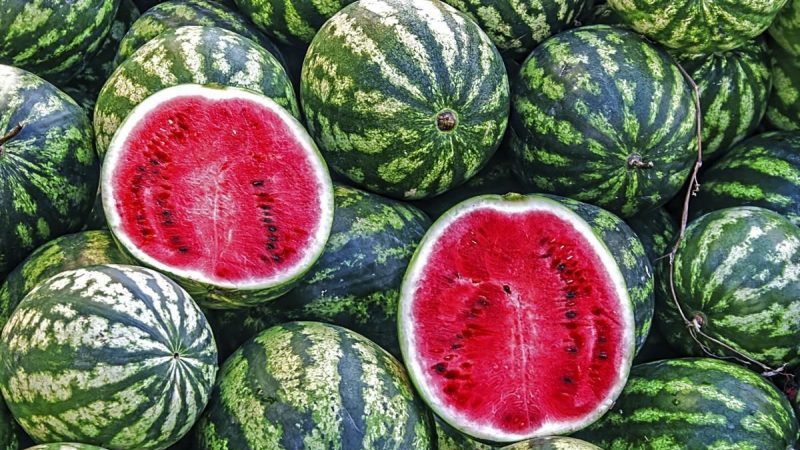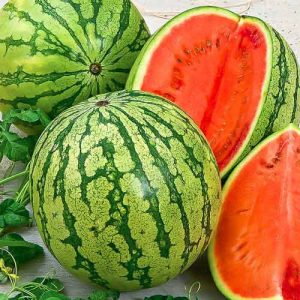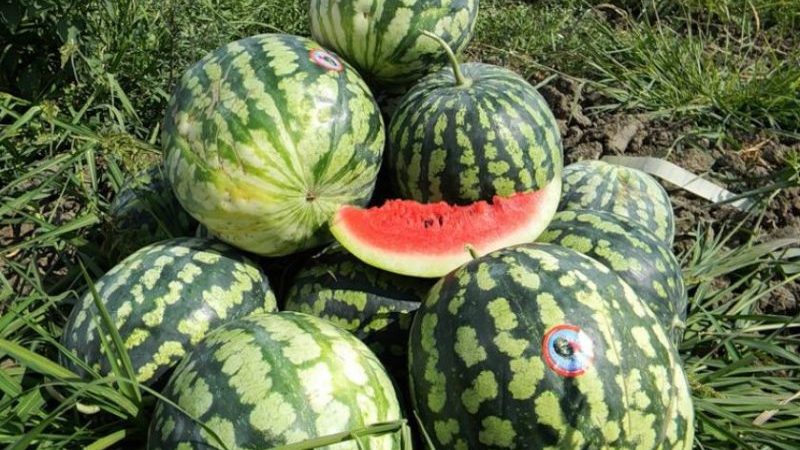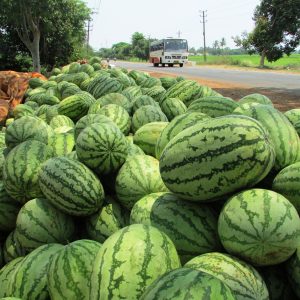Why Astrakhan watermelon is good and why farmers love it so much
Today, Astrakhan, unpretentious in care watermelon grown throughout Russia, although this was not always the case. Breeders had to work hard for more than a dozen years so that the southern fruit could grow in more severe climatic conditions.
This variety gives a high yield and has a long shelf life. Our article will tell you how to distinguish the Astrakhan variety from others and how to grow it.
The content of the article
What kind of watermelon is this
The popularity of the variety is associated with increased resistance to various diseases and excellent keeping quality - the fruits are sweet and tasty, retain these qualities for about two months.
History of origin and distribution
Initially, all the fruits of this plant grown in the Astrakhan region were considered Astrakhan watermelon. And only in 1977, a variety with this name was registered.
Interesting! Peter 1, who tasted watermelons in Astrakhan, was so impressed by their taste that he ordered to start them cultivation under Moscow. Immediately, however, nothing came of it, and only in the 19th century did the first varieties appear that successfully bore fruit in cold climates.
At the time of Peter 1, watermelons were produced of two types - for sale and for feed to livestock. People bought large fruits that weighed more than 10 kg, the rest, which did not pass by weight, were fed to animals.

Feature and Description
The Astrakhan variety is thermophilic, and under favorable conditions the harvest is of high quality. The plant gives medium length lateral shoots, it is recommended to leave no more than three.
It is enough to leave two ovaries on long loops, then the fruits will ripen better and get more juice.
Distinctive features
The fruits of Astrakhan watermelons are large, at least 8 kg in weight. Ripe, well-ripened fruits have excellent taste, tolerate transportation well and can be stored for more than 2 months. In addition, the variety has a high yield; with proper cultivation techniques, more than 12 tons of watermelons are obtained from 10 acres.
Most of the diseases that plague melons and gourds are not terrible for the Astrakhan variety. It is resistant to fusarium and anthractosis. Undemanding to soil and conditions. It has a medium early ripening time - ready for harvesting 75 days after germination.
Description of fruits, appearance
The fruits of the Astrakhan variety are round, less often slightly elongated, the peel is smooth, even with stripes of dark and light green shades.
Interesting! Professionals believe that the greater the difference in tones between the dark and green stripes of a watermelon, the sweeter it will be.
Ripe watermelon inside is bright red, the pulp is sugary and juicy, exudes a pleasant fresh aroma. Seeds are dark, brown, rarely black. And an important difference between this variety is the presence of a thick rind.
Reference! The tail of a ripe watermelon should be dry, and a specific ringing is heard when you hit the peel.
Composition, properties

Watermelons are 80% water. The remaining 20% is fructose, vegetable fiber and trace elements. Most of all, watermelons are useful for those who have problems with the heart, blood vessels and joints. The product has a strong diuretic effect.The sweet flesh, when consumed in moderation, will not harm insulin-dependent diabetic patients.
Of the trace elements, watermelon contains the most magnesium, it is especially useful for high blood pressure. The berry prevents the appearance of kidney stones, stimulates the biliary tract and promotes the removal of cholesterol from the body. Magnesium helps to reduce nervous excitability, relieves muscle spasm and normalizes bowel function.
Interesting! 100 g of watermelon pulp contains 224 mg of magnesium, more only in almonds. For the daily rate, it is enough to eat 150 g of watermelon per day.
There is not as much potassium in watermelon as in some other fruits. But when counting calories, watermelon still wins. It is not recommended to eat watermelon in case of indigestion, diarrhea, tendency to edema.
Important! Watermelon grown with nitrates will gain weight and ripen faster, but if ingested, it will cause severe poisoning. It is dangerous to eat such fruits.
How to distinguish from other varieties
Outwardly, different varieties of watermelons are similar, but if you look closely, the pattern of the stripes is different. The Astrakhan variety is distinguished by jagged stripes of two colors. As a rule, one of them is light and almost white, and the second is dark emerald.
Also, these fruits differ from other varieties by the presence of a thick rind - at least 2.5 cm. Astrakhan watermelons are sold with appropriate stickers, they are large (about 10 kg) and green.
Advantages and disadvantages of the variety
The main advantage of the Astrakhan watermelon is the sweet sugar pulp and the ability to quench your thirst even in extreme heat. This dietary product is used both fresh and pickled.
The fruits of the Astrakhan watermelons:
- long are kept after harvest;
- they are easy to transport - they do not lose their appearance, do not crack, taste does not spoil;
- the variety is unpretentious in cultivation, does not require complex leaving;
- can be grown both outdoors and in a greenhouse;
- not prone to most diseases inherent in melons;
- gives a large harvest.
In fact, no shortcomings of the variety have been recorded, except for the thick crust.

Growing regions
Since watermelon is still thermophilic, it prefers to grow in the southern regions. But the variety has completely adapted to central Russia, Astrakhan watermelons are grown in Moscow suburbs, in the Urals and in Siberia, but mostly in a greenhouse way.
Features of agricultural technology
In the southern regions, seeds are sown directly into open ground, and in colder regions, they use the seedling method. To do this, first the seeds are sown in special containers, followed by picking in places with a larger area.
Landing
Before planting, watermelon seeds are kept in an aqueous solution with potassium permanganate and zinc for 24 hours. This procedure will harden the seeds and disinfect them, protecting them from some diseases. After 24 hours, they are wrapped in cheesecloth and placed in a saucer with waterth. The air temperature should be at least 27 ° C, so the seeds remain until they sprout.
In about a month, the seeds will hatch and they can be sown on the site or in a container for seedlings. The soil must be fertilized with peat, and the containers can be completely filled with it. When four leaves appear, it is time to plant the plants in a permanent place.
Important! Seven days before planting seedlings in the ground, the air temperature is gradually reduced to 21 ° C.
The sunniest place is chosen for landing. There should be no trees or tall buildings nearby that could obscure the sun. Before planting, the site is thoroughly cleaned of weeds.
Interesting! Watermelons do well after potatoes, legumes, and corn. Do not plant them after other melons, cucumbers or cabbage.
For a watermelon, neutral soils are suitable, they do not tolerate acidic soils.
Care
In order for the watermelon to get more heat, the ground is covered with mulch - this will keep the temperature around + 10 ° C and will not let the ground dry out.Watermelon responds to nitrogen-containing mixtures and potassium-phosphorus compositions.
Weeding is carried out regularly. Watering is not often, but it is strengthened during the growth of the main stem... When the fruits have formed, the volume of water is reduced to ripen faster:
- once a week during the flowering period;
- twice a month when forming ovaries;
- do not water during the ripening period.
Potential problems and solutions
Most often, melons are harmed by:
- aphid;
- spider mite;
- wireworm.
At home and for small plantings, it is easy to use a solution of wood ash and garlic. One month before harvesting, no preventive and medical work should be performed. If the plant is badly damaged, then it is removed from the melon and burned.
Since the Astrakhan variety is not susceptible to disease, growing problems are rare. In case of damage to the plant, it is best to use specialized preparations.
Of the folk methods in the fight against bacteriosis and powdery mildew, mullein infusion diluted with three parts of water will help. From purchased drugs, you can use Bordeaux mixture, "Decis", "Skor".
Optimal conditions for good growth and rich harvest
The Astrakhan variety does not ripen before August. Only by September does the harvest peak.
Interesting! It will not be possible to grow a good harvest of watermelons on black soil - a large amount of nitrogen in the composition feeds the tops, and the fruits remain small.
When planting watermelons in the ground, the distance between them is at least 80 cm, and between the rows - more than 1 m. The seeds are not buried more than 4 cm. The soil temperature during planting should be + 16 ° C and higher.
The watermelon will grow tasty and juicy if the daytime temperature is not lower than + 29 ° С, and the night does not fall below + 19 ° С. It is important to observe the watering regime.
The presence of groundwater close to the surface will also be badly reflected. It is better to choose another site for planting watermelons.
How to protect against cold and other adverse factors
If the seedlings are only planted in the ground and an unexpected cold snap has occurred, then the easiest way is to cover the planting with a film. This will warm the plants and keep them from freezing. As soon as the weather is good, the shelter is immediately removed - the sun's rays are vital for the watermelon. In general, a short-term cold snap will not bring much harm to the watermelon, the main thing is to warm the roots, and mulching with a layer of at least 5 cm will help in this.
Harvesting and storage
The watermelon is picked only when it is fully ripe. A plucked green fruit cannot ripen.
Signs of a ripe watermelon:
- examine the stalk and antennae - they must dry;
- the fruit peel becomes shiny, the pattern is clearer, and the colors are brighter;
- a large yellow spot appears on the ground;
- when struck with a palm, a resonant ringing appears.
Cut the watermelons with a knife, and leave the tail about 4 cm.
A dark, dry room with good ventilation is suitable for storing watermelons. The air temperature should be no more than 7 ° С.
Conclusion
Astrakhan watermelons are delicious and sweet, ripen in August or September, but not earlier. They are not demanding to care for and can be stored for a long time under the right conditions. Useful watermelon is indicated for certain diseases and perfectly quenches thirst in the heat.